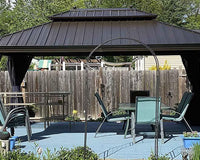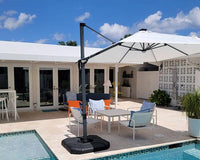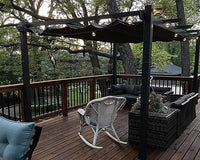Sunrooms do wonders in your house, and they are the perfect place for soaking in the sun and relaxing. However, outside noise often spoils peace. If the buzz of traffic or the lawn mower of your neighbor consistently ruins the peace, there is no need to get worried because here comes this article to help. We'll show some pretty straightforward ways to soundproof your sunroom. By the end of this guide, you will know how to keep those unwanted sounds out so you can kick back, enjoy the light, and savor the quiet in your cozy corner.
Figure Out Your Sunroom's Noise Factor
First, you want to understand the kind of noise invading your sunroom and from where. Noise may be airborne, such as when dogs bark. Noise can also impact noise, such as the vibrational feel of footsteps from above the floor.
Identify Weak Spots
Take your notebook into your sunroom and take the time to listen. Note the kinds of noises that you hear, from what sources, whether the traffic noise is louder near the door or if there's one particular window with a constant whir. The more detailed you are, the better you'll be able to identify which parts of your sunroom require your attention most.
Set Goals for Soundproofing
Decide how much quiet you want. If it's just a matter of dulling the noise enough so you can read comfortably in the afternoons, that's one thing; if you want to make that room into a recording studio, then that's quite another. Keep in mind that completely soundproofing a room is a pretty intensive process; often, it's enough to merely bring the noise level down far enough to make it unobjectionable.
1. Start with Windows, Doors, and Skylights
Your sunroom's windows, doors, and even skylights are the main entry points for outside noise. By focusing on these first, you'll be dealing with the biggest culprits of sound leakage.
Windows
Ordinary glass panes are thin — they're not great at blocking noise. Upgrading to double or triple-pane windows adds layers of glass and air that significantly reduce sound transmission. If complete replacement is out of budget, consider soundproof window inserts or applying acoustic sealants around the window frames to fill in any gaps where noise sneaks through.

Doors
The door to your sunroom might have poor insulation, letting noise pour in. Weatherstripping is an easy DIY fix that can plug the spaces around the door edges. For more serious sound blockage, you might want to look into solid-core doors, which offer a denser material for sound to penetrate, making your sunroom quieter.
Skylights
Skylights invite both light and noise. If they're single-paned, consider upgrading to a laminated glass option. Laminated glass incorporates a layer of vinyl between sheets of glass, creating a barrier that dampens sound vibrations.
2. Enhancing Wall Insulation
Properly insulated walls are a must to absorb the several outside noises that would disturb your sun-kissed haven.
Choosing the Right Insulation
All kinds of options exist for wall insulations, but if the purpose is soundproofing, then materials such as stone wool or fiberglass batts are considered to be one of the best options, given that they have magnificent sound-absorbing properties. These materials also are going to help keep the temperature regulated, making your sunroom comfortable throughout the year while playing a major role in noise reduction.
DIY Soundproofing Steps
If you're handy and the structure of your sunroom permits, adding or replacing insulation might be a weekend project. It involves removing interior wall panels and fitting new insulation into the wall cavities. For an easier fix, consider adding mass-loaded vinyl (MLV) over existing walls. This heavy yet flexible material can be cut to size and attached directly to walls, offering a high degree of sound blockage without major construction.
Alternative Solutions
In that case, where the wall structure cannot be changed, acoustic wall panels will help in sound absorption. These are available in many colors and styles; thus, you can easily maintain the aesthetic appeal of your sunroom while improving the acoustics.
Remember, each layer applied will help decrease the volume of outside noise and create a more serene sunroom environment in which to relax or entertain without the interruption of the outside world.
3. Floors and Ceilings
The surfaces underfoot and overhead can be just as responsible for letting in noise as walls and windows.
Flooring Strategies for Noise Reduction:
If you have tile or wood, for example, in your sunroom, it is going to look great, but these features can really bounce the sound around. Laying thick rugs with underlays of rubber has the potential to reduce this sound. Such materials will absorb much of the sound waves coming your way instead of reflecting them. If you need something more permanent, try installing a sound-deadening underlayment below your flooring. Materials like cork or specialized acoustic mats make a big difference.
Ceiling Considerations for a Quiet Room:
Soundproofing the ceiling can sometimes be overlooked, but if your sunroom has a room above it or if it's exposed to the elements, this area is key. Acoustic tiles are an excellent choice for drop ceilings, while decorative acoustic panels can add both aesthetic value and sound absorption to solid ceilings. If you're able to access the space above, adding insulation between the ceiling joists may provide significant noise reduction.
4. Sealing the Soundscape
Small gaps and cracks can undermine even the most robust soundproofing efforts by allowing noise to sneak through. Ensuring these are sealed is a cost-effective way to enhance your sunroom's serenity.
Detect and Seal Air Leaks
Begin with a thorough investigation of your sunroom during a windy day. Feel around windows, doors, electrical outlets, and where walls meet floors and ceilings for drafts. Use a lit incense stick or candle flame; if the smoke wavers or the flame flickers, there's likely an air leak present.
Acoustic Sealants and Weather Stripping
Once you've found the leaks, it's time to seal them. Acoustic caulk is designed to seal these types of leaks and can be applied along window and door frames, as well as any cracks in the walls. It remains flexible when dry, preventing cracks from forming as materials expand and contract with temperature changes. For doors and operable windows, weather stripping is an excellent ally to stop noise from infiltrating the edges.
Regular Maintenance
Keep in mind that over time, buildings settle and materials degrade, so those pesky gaps can reappear. Making gap inspection and sealing part of your regular home maintenance routine will ensure ongoing protection against noise intrusion.
5. Furnishings and Decor
The role of furnishings and decor in soundproofing is often underestimated. Not only do they add personal flair to your sunroom, but they also serve as functional elements to dampen noise.
Soft Touches
Soft materials absorb sound waves much more effectively than hard surfaces. Incorporate plush sofas, cushioned chairs, or bean bags into your sunroom. Heavy curtains can also act as a barrier against noise coming through the windows while adding texture to your space.
Bookshelves and Plants
Tall bookshelves full of books aren't only good for decoration; they do a great job of diffusing sound waves. In the same way, indoor plants can have a similar effect. Placed properly, these natural sound barriers can greatly cut noise levels.
Strategic Placement
Place your sound-absorbing furniture and decor where the noise is noisier. If one wall lets in the traffic noise, place a bookshelf there. If the echo is loud, lay down a thick rug or hang up curtains across a window or glass door. It is all about finding the right balance between functionality and design.
Build Your Sanctuary of Silence
From taking you through strategies that begin with noise profiling to windows, walls, floors, and ceiling enhancements, right to the very end of infusing your space with the richness of sound-absorbing furniture and decor, you now have the complete armory to transform your sun-lit retreat into a quiet haven. With every step that is undertaken, no matter how minute it may seem, this adds to the general tranquility of the space.
With these tools at your fingertips, you can look forward to a whole lifetime of peaceful moments in quietness, free from the murmur and noise outside your haven. In reaching your quest for quietude-whether embracing do-it-yourself repairs or calling the pros in-this sunroom of yours will remain a place where relaxation and serenity are just as ample as the natural light entering through its glass.




